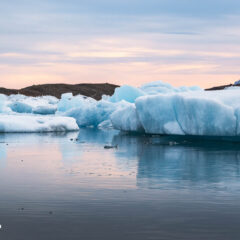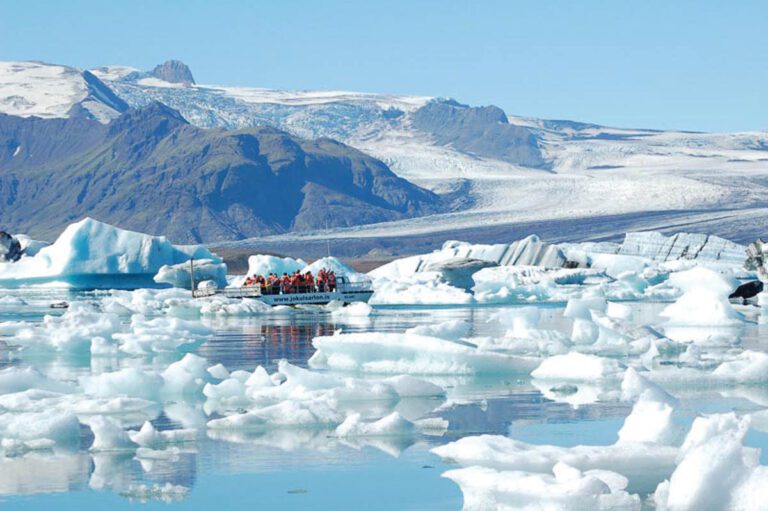Diamond Beach: Exploring Fellsfjara, the Sparkling Shorelines
- South Iceland
- 8 Sep 2023
Discover the enchanting allure of Diamond Beach in Iceland, where the juxtaposition of glittering icebergs against the dramatic black volcanic sands creates a captivating spectacle. This surreal destination beckons photographers and nature lovers alike, inviting you to immerse yourself in Iceland's awe-inspiring nature.

What is Diamond Beach?
Known to tourists as the ‘Diamond Beach,’ the captivating black sand beach adjacent to Jokulsarlon Glacier Lagoon is beautifully named Fellsfjara. It’s also referred to as Fellsfjara at Breiðamerkursandur.
Here, the sands are strewn with chunks of glacial ice, carried along the river Jökulsá á Breiðamerkursandi, towards the sea, and then gracefully returned to the sands by the tides.
This natural phenomenon creates a dazzling effect, with the sparkling ice chunks scattered on the black sands earning the beach its nickname of ‘Diamond Beach.’
Where is Diamond Beach Located
South Coast of Iceland
Diamond Beach is located on the south coast of Iceland, near the renowned Vatnajökull National Park. It is within easy access from the Ring Road and popular road trip routes, making it a must-see destination for visitors to Iceland. The beach is a part of Iceland’s fascinating volcanic landscape, which is characterized by its black sand – a result of basalt lava in the region.
You can find this mesmerizing attraction not too far from the city of Reykjavik, at the edge of the vast Vatnajökull Glacier – the Iceland’s largest and Europe’s most voluminous ice cap. The glacier itself is an extraordinary natural wonder that plays a significant role in the beauty of Diamond Beach. Icebergs calved from the nearby Breiðamerkurjökull, an outlet glacier of Vatnajökull, wash ashore on the black sands, creating the incredible, shimmering display that gives this beach its name.

While the journey from Reykjavik may be relatively long, taking around 5 hours by car one-way, the stunning and diverse landscape of the south coast makes the trip an unforgettable experience. Along the way, you will encounter various other natural attractions, including waterfalls, black sand beaches, and charming coastal towns.
Now, let’s pack our bags and prepare for an awe-inspiring trip to Diamond Beach and its astonishing surroundings.

Unique Features
Black Sand
One of the most striking features of Diamond Beach is its black sand, which contrasts beautifully with the glistening ice that washes up on its shores. The black sand is a direct result of Iceland’s volcanic landscape. The sand comes from the basalt lava found within the region. Active volcanoes like Katla within the Vatnajökull National Park continue to add black sand to some Icelandic beaches.

Diamonds
The name “Diamond Beach” is derived from the various shapes and sizes of ice chunks that get washed up on the shore, reminiscent of glittering diamonds. These ice chunks are remnants of the nearby Jökulsárlón glacier lagoon. The combination of the glistening ice against the black sand makes for a breathtaking and unique landscape, setting Diamond Beach apart from other locations.

Icebergs
The stunning icebergs that adorn Diamond Beach are thanks to its proximity to the Jökulsárlón glacier lagoon. As glaciers break apart and form icebergs, they make their way through the lagoon, drifting towards the narrow waterway that leads to the Atlantic Ocean. Eventually, these large ice formations wash up on Diamond Beach, creating a mesmerizing sight for visitors.
To fully appreciate the stunning beauty and distinctive characteristics of Diamond Beach in Iceland, you must experience it in person.

Visiting Times and Weather
Summer Experience
During the summer months, Diamond Beach offers a unique and stunning experience. The midnight sun allows you to visit the beach at any time, even as late as 2 am. This means that we can avoid the crowds and truly immerse ourselves in the beauty of the glistening icebergs on the black sand beach. The summer weather in Iceland is generally mild, making it a pleasant time to explore the area and take in the breathtaking views. With clear skies, you can see the Jökulsárlón glacier in all its glory.

Winter Excursions
Winter at Diamond Beach also has its own charm, as the Northern Lights can illuminate the sky and create once-in-a-lifetime views. The icebergs reflect the mesmerizing colors of the aurora borealis, creating a magical atmosphere3. However, visiting during the winter months can be more challenging due to Iceland’s unpredictable weather4. You might encounter snow and colder temperatures, but if you are lucky enough to have a sunny day, the icebergs against the black sand beach are truly captivating. Be prepared for shorter days as the sun sets at wildly different times during winter4.
While both summer and winter offer their own unique experiences, the best time to visit Diamond Beach would ultimately depend on our personal preferences, whether that be the enchanting midnight sun of summer or the ethereal beauty of the Northern Lights in winter.

Natural Marvels
Northern Lights
One of the most mesmerizing natural marvels you can witness at Diamond Beach is the Northern Lights. These breathtaking displays of nature occur when particles from the sun collide with Earth’s atmosphere, creating vibrant auroras that light up the sky. The best time to catch the Northern Lights in Iceland is between September and April, when the nights are longest and the skies are the darkest.

Waterfalls
Vatnajökull National Park, home to Diamond Beach, is also known for its stunning waterfalls. The park boasts a wide range of cascading beauties, each with its distinct character and charm. While exploring the area, you can marvel at these incredible displays of nature’s power, such as the famous Svartifoss in Skaftafell. This waterfall’s unique black basalt columns create a mesmerizing backdrop to the tumbling waters.

Ice Caves
Another natural wonder that is not to be missed in Vatnajökull National Park is the ice caves found within its glaciers. These caves are formed by meltwater channels, creating complex and awe-inspiring networks of tunnels under the ice. The vibrant blue hue and icy formations make these caves both a striking visual experience and an unforgettable reminder of the power of nature. To explore the ice caves, it’s recommended to join a guided tour led by experienced professionals who prioritize safety and provide valuable insights into the natural formations.
During our time at Diamond Beach and Vatnajökull National Park, you have the privilege of experiencing the awe-inspiring beauty of nature in its many forms. From the dancing colors of the Northern Lights to the thundering power of waterfalls to the ethereal allure of ice cave, these natural marvels enrich our understanding and appreciation of our incredible world.

Visiting the Diamond Beach Safely
- Dress Warmly: Icelandic weather can be unpredictable, so layer up with waterproof clothing, sturdy boots, and don’t forget gloves, a hat, and a scarf.
- Safety First: Be cautious around the icebergs, as they can be unstable. Do not climb or touch them, and keep a safe distance from the water’s edge.
- Parking: Diamond Beach is adjacent to Jökulsárlón Glacier Lagoon, which offers parking facilities. Arrive early to secure a spot during peak tourist season.
- Respect Nature: Iceland’s pristine environment is fragile. Dispose of trash responsibly, follow designated paths, and respect the local wildlife.
- Be Weather Aware: Keep an eye on weather forecasts and road conditions, as they can change rapidly. Drive cautiously on the icy roads leading to Diamond Beach.

Photography Pointers
Sunset & Sunrise
As photographers, capturing Diamond Beach during the golden hours of sunset and sunrise is a great approach. These periods often provide warm, soft lighting conditions, allowing us to showcase the stunning ice formations in an ethereal way. The sun’s position near the horizon creates dramatic shadows and textures, emphasizing the contrast between the glistening ice and the dark black sand. To make the most of these conditions, I recommend scouting the beach in advance to find the best composition and camera settings.

Reflection and Ice
One of the most striking features of Diamond Beach is the way the ice glistens and reflects sunlight, making it a truly unique and mesmerizing location. To take full advantage of this, I recommend focusing on the interplay between the ice formations and their reflections in the water. Use a polarizing filter to minimize glare and bring out the details in the ice, while using a tripod to stabilize your camera and ensure sharp, well-composed images.
When photographing the ice, consider experimenting with different angles and perspectives to capture unique, eye-catching shots. For example, you can:
- Get close to the ice formations, using a wide-angle lens to accentuate their size and texture.
- Explore the contrast between the vibrant blue ice and the black sand by positioning yourself to capture reflections in the shallow water.
- Use a longer focal length to isolate specific ice formations and emphasize their unique shapes.
- Experiment with different shutter speeds and apertures to create a variety of artistic effects in your images, such as softening waves or emphasizing the movement of the water around the ice.
By employing these strategies and creatively exploring the opportunities at Diamond Beach, you can produce captivating photographs that truly showcase the beauty and wonder of this remarkable location.

Local Conservation
Biodiversity
At Diamond Beach, the rich biodiversity of the local environment is very much praised by the locals. Among the many marine species thriving in the area, seals are one of the most notable. They can often be seen basking on the shore or swimming in the nearby waters. Diamond Beach plays a crucial role in providing a habitat for these animals, along with several other marine species. To support ongoing efforts to protect this delicate ecosystem, Iceland participates in local conservation initiatives, collaborating with organizations like The Nature Conservancy and U.S. Fish & Wildlife Service.
Climate Change Impacts
Climate change influences the health and long-term sustainability of the ecosystems at Diamond Beach. Rising sea levels, erosion, storm surges, and other climate-related impacts may threaten the coastal environment, with potential effects on our beloved seals and other wildlife. To ensure the resilience of our local ecosystem, the local community actively integrates climate change adaptation strategies into our conservation efforts. This includes monitoring environmental conditions, working to protect our coastline, and collaborating with experts to address these challenges.
Frequently Asked Questions about Diamond Beach
What are the must-see attractions near Diamond Beach?
While visiting Diamond Beach, it’s essential to explore the Jökulsárlón glacier lagoon. The lagoon is just across the road from the beach and is known for its magnificent icebergs that break off from the Vatnajökull glacier and float in the water. Another must-see in the area is the Vatnajökull National Park, which provides countless opportunities for hiking, wildlife encounters, and visits to breathtaking waterfalls.

What is the difference between Diamond and Reynisfjara black sand beach?
Both Diamond Beach and Reynisfjara Beach in Iceland are known for their distinctive black sand. However, the sand in Diamond Beach is a result of nearby volcanic activity, where hot lava once turned into black sediment. In contrast, Reynisfjara’s black sand is formed by erosion of volcanic rocks.
The picturesque appeal of both beaches differs, too. Diamond Beach is famous for the ice blocks that wash ashore from the Jökulsárlón glacier lagoon, resembling glittering diamonds. On the other hand, Reynisfjara Beach is recognized for its iconic basalt columns and powerful waves crashing against the shore.

Are there real diamonds at Diamond Beach?
Despite its name, there are no real diamonds found at Diamond Beach. Rather, the moniker is derived from the appearance of the ice blocks that wash ashore from the glacier lagoon. These blocks resemble precious stones glistening amid the contrasting black sand, giving the beach its unique and enchanting appeal.


















